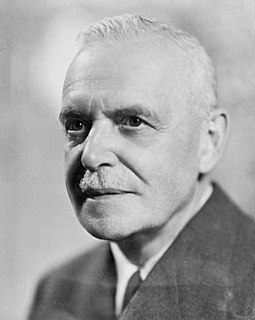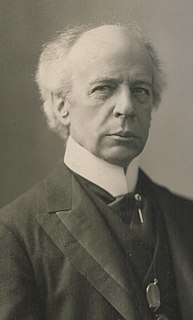
The Canadian federal election of 1949 was held on June 27 to elect members of the House of Commons of Canada of the 21st Parliament of Canada. It was the first election in Canada in almost thirty years in which the Liberal Party of Canada was not led by William Lyon Mackenzie King. King had retired in 1948, and was replaced as Liberal leader and Prime Minister by Louis St. Laurent. It was also the first federal election with Newfoundland voting, having joined Canada in March of that year, and the first election since 1904 in which the parts of the Northwest Territories were granted representation. The Liberal Party was re-elected with its fourth consecutive government, winning just under 50% of the vote. This victory was the largest majority in Canadian history to that point and remains, by any measure, the largest-ever majority won by the Liberal Party. As of 2017, it remains the third largest majority government in Canadian history.

The Canadian federal election of 1908 was held on October 26 to elect members of the House of Commons of Canada of the 11th Parliament of Canada. Prime Minister Sir Wilfrid Laurier's Liberal Party of Canada was re-elected for a fourth consecutive term in government with a majority government. The Liberals lost four seats and a small share of the popular vote.

Nick G. Sibbeston is a retired Canadian Senator representing the Northwest Territories. He was nominated to the Senate by Liberal prime minister Jean Chrétien in 1999 and sat until 2017, when he resigned on his 74th birthday, a year prior to reaching the mandatory retirement age. Prior to that, he was Premier of the Northwest Territories from 1985 to 1987. He was also a Member of the Legislative Assembly in the Northwest Territories representing Mackenzie-Laird from 1970 to 1975 and from 1979 until 1991.
The Northwest Territories General election of 1951 held on September 17, 1951 was the sixth general election in the Northwest Territories, Canada, and the first since the 1902 election. The election came about after The Northwest Territories Act was amended to permit three elected members from the Mackenzie District to join the five appointed members on the Executive Council of the Northwest Territories. The Council, which had met in Ottawa, Ontario, outside of the Northwest Territories, shortly after the election, the council began to alternate sittings between Ottawa and Northwest Territories communities.

The Northwest Territories general election of 1898 took place on 4 November 1898. This was the fourth general election in the history of the Northwest Territories, Canada. It was held to elect members of the Legislative Assembly of the Northwest Territories.

The Northwest Territories general election of 1902, occurred on 21 May 1902 and was the fifth general election in the history of the Northwest Territories, Canada. It was held to elect Members of the Legislative Assembly of the Northwest Territories. This was the last election held until 1951, and was the last in the Northwest Territories to have political parties.
The Northwest Territories general election of 1894 was held on 31 October 1894. This was the third general election in the history of the Northwest Territories, Canada. It was held to elect members of the Legislative Assembly of the Northwest Territories, the writs were dropped on 3 October 1894. Frederick Haultain continued to lead the government.
The Northwest Territories Liberal Party was a short-lived branch of the Liberal Party of Canada in the Northwest Territories.

The history of Northwest Territories capital cities begins with the purchase of the Territories by Canada from the Hudson's Bay Company in 1869, and includes a varied and often difficult evolution. Northwest Territories is unique amongst the other provinces and territories of Canada in that it has had seven capital cities in its history. The territory has changed the seat of government for numerous reasons, including civil conflict, development of infrastructure, and a history of significant revisions to its territorial boundaries.
Richard Nerysoo is a territorial level politician from the Northwest Territories, Canada. He was a member of the Northwest Territories Legislature from 1979 to 1995 and served as the third Premier and Speaker.
The Politics of Northwest Territories involves not only the governance of the Northwest Territories but also the social, economic and political issues specific to the territory. This includes matters relating to local governance and governance by the federal government of Canada, the inclusion of the aboriginal population in territorial affairs, and the matter of official languages for the territory.
This article provides a timeline of elections in Canada, including all the provincial, territorial and federal elections. The information starts from when each province was formed or entered the Confederation, and continues through to the present day.
Donald Morton Stewart is a former politician and civil servant from Northwest Territories, Canada.
Norman Yakeleya is a territorial level politician from Northwest Territories, Canada.
Paul Alfred Delorey is a Canadian professional curler, a retired territorial level politician and former speaker of the Northwest Territories (NWT) Legislature.
Robert Hawkins is an engineering technologist and a former municipal and territorial level politician from Northwest Territories, Canada.
Charlie Crow is a former disc jockey and Member of the Northwest Territories Legislative Assembly from 1987 to 1991.
Moses Appaqaq Jr. is a soapstone carver, former retail clerk, and former territorial-level politician from Sanikiluaq, Northwest Territories.
Joe Arlooktoo is a northern Canadian artist, adept at soapstone and ivory carving, and a municipal and territorial-level politician who was a member of the Northwest Territories Legislature from 1979 until 1991. He is a current councilor of Kimmirut, Nunavut.






